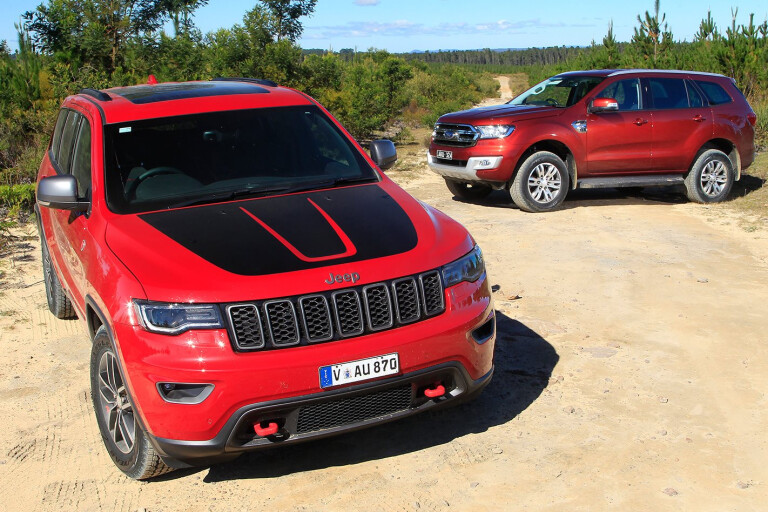
THE hero in Jeep’s revamped 2017 Grand Cherokee range is the new Trailhawk, the most off-road-orientated model to appear in this current generation range, which has been with us since 2011.
At $74,000 (plus on-road costs) it sits between the mid-spec Limited and the luxurious Overland in both price and kit.
 With that price tag, we had hoped to compare the Trailhawk to the $75,000 Everest Titanium, but had to make do with the $59,000 mid-spec Everest Trend. The upside here is that the Trend comes with 18s, instead of the Titanium’s more damage-prone and less-off-road-effective 20s.
With that price tag, we had hoped to compare the Trailhawk to the $75,000 Everest Titanium, but had to make do with the $59,000 mid-spec Everest Trend. The upside here is that the Trend comes with 18s, instead of the Titanium’s more damage-prone and less-off-road-effective 20s.
2017 Ford Everest Trend
Two years ago the Everest Trend was our 4X4 Of The Year, and in previous iterations the Grand Cherokee has received a 4X4OTY award twice. However, while these wagons come into this contest well-credentialed, they also come from very disparate design backgrounds.
The Everest has a separate chassis and a live rear axle, while the Grand Cherokee has a more passenger-car design being a monocoque with fully independent suspension – even though the original platform was designed for an SUV (Mercedes ML), so it’s not without off-road context.
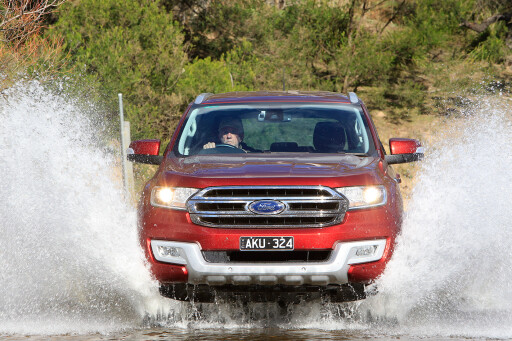 The respective drivetrains also provide significant differences. Where the Jeep has a 3.0-litre V6 diesel with an eight-speed automatic, the Ford has a bigger diesel (3.2 litres) with less cylinders (five) and a six-speed automatic.
The respective drivetrains also provide significant differences. Where the Jeep has a 3.0-litre V6 diesel with an eight-speed automatic, the Ford has a bigger diesel (3.2 litres) with less cylinders (five) and a six-speed automatic.
Arriving in late 2015, the Ford Everest is essentially a wagon sculptured from a ute, in this case Ford’s highly successful Ranger. Aside from the obvious change to the wagon body, there are coil springs in place of leaf springs for the rear live axle, disc brakes instead of drums and, at the rear, a shortened wheelbase and a ‘active’ full-time 4x4 system rather than the Ranger’s more utilitarian part-time 4x4 system.
 All three Everest models seat seven, a feat in part made possible by a wheelbase that’s still as long as a Land Cruiser 200. Interestingly, the Grand Cherokee has an even longer wheelbase, but all models only seat five.
All three Everest models seat seven, a feat in part made possible by a wheelbase that’s still as long as a Land Cruiser 200. Interestingly, the Grand Cherokee has an even longer wheelbase, but all models only seat five.
Powertrain and performance
The Everest shares what is essentially the Ranger’s 3.2-litre in-line five-cylinder diesel engine, post the 2015 upgrades. In one departure from the Ranger, the Everest has AdBlue pollutant-reducing technology, which allows it to meet upcoming Euro Six emissions regulations, a tech update the Ranger will need to remain on sale.
The ‘big’ in-line five-cylinder – it’s bigger in capacity than the Trailhawk’s V6 – has a unique and likeable feel. It’s a bit lumpy at idle, but, as you’d expect from an in-line five, it quickly becomes delightfully smooth with a few revs on board and, unlike competitor four-cylinder diesels, doesn’t need power-robbing balance shafts to achieve this.
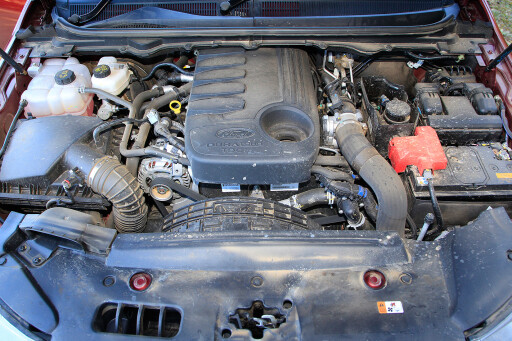 Once underway it offers effortless performance, even at modest revs thanks to its solid 470Nm torque peak coming on stream at a low 1750rpm and remaining on tap until 2500rpm.
Once underway it offers effortless performance, even at modest revs thanks to its solid 470Nm torque peak coming on stream at a low 1750rpm and remaining on tap until 2500rpm.
The six-speed automatic also works nicely with the engine’s low-rpm grunt, and the overall gearing – shorter than many these days – means the engine holds top gear comfortably in give-and-take highway driving. It has nicely calibrated shift protocols, too, and decent shift quality from the ZF six-speed.
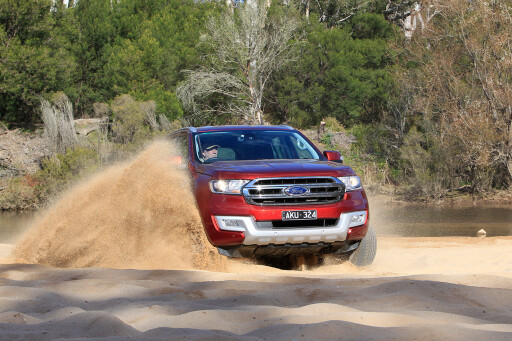 The engine is a bit gruff and noisy by today’s standards, something particularly noticeable against the Trailhawk’s V6 or even the 2.8-litre four-cylinder in the Prado. It’s also a tad on the thirsty side (as it is in the Ranger), and in this contest it used about five per cent more fuel than the more powerful V6 in the Trailhawk – not good for its comparative touring range when the Jeep also has an extra 13.5 litres of fuel capacity.
The engine is a bit gruff and noisy by today’s standards, something particularly noticeable against the Trailhawk’s V6 or even the 2.8-litre four-cylinder in the Prado. It’s also a tad on the thirsty side (as it is in the Ranger), and in this contest it used about five per cent more fuel than the more powerful V6 in the Trailhawk – not good for its comparative touring range when the Jeep also has an extra 13.5 litres of fuel capacity.
Not that range, economy and NVH are the only advantages the Trailhawk’s smaller six has over the Everest’s bigger five.
On-road ride and handling
The local development of the Everest has paid off in terms of on-road dynamics, especially given the ute starting point and attendant compromises.
Despite its hefty weight – around 2400kg – and height, the Everest feels quite sporty through corners and offers a compliant ride. The active full-time 4x4, which proportions the drive front to rear as conditions demand, gives security and ease of use over varying road conditions.
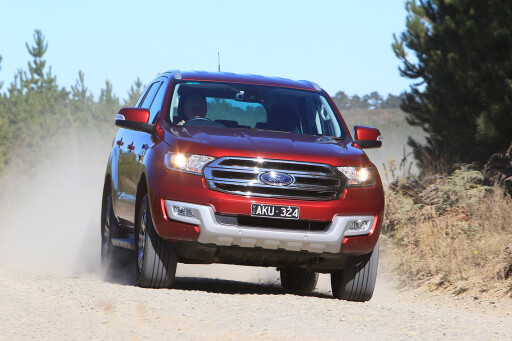 The Everest’s electric power steering, which is feather-light at parking speeds, firms up nicely at road speeds to offer plenty of feel and feedback and enhance the driving experience.
The Everest’s electric power steering, which is feather-light at parking speeds, firms up nicely at road speeds to offer plenty of feel and feedback and enhance the driving experience.
As mentioned, the Ranger’s rear leaf springs make way for coils and, while a live rear axle is retained, it’s located by a Watt’s linkage rather than the simple and ubiquitous Panhard rod. It works well, but – on-road at least – not as good as the independent rear suspension of the Jeep Trailhawk.
Off-Road
The Everest’s tidy on-road performance is complemented by what is perhaps an even better performance off-road. Here, the rear live axle and its extra travel is an advantage, and there’s decent travel at the front, too.
The Everest’s active centre diff is also a bonus off-road by not only directing the drive where it can be best used, but by allowing more sophisticated tuning of the driver-switched off-road programs (Grass/Gravel/Snow; Sand; Rock) for the Terrain Management System, a system similar to Land Rover’s Terrain Response.
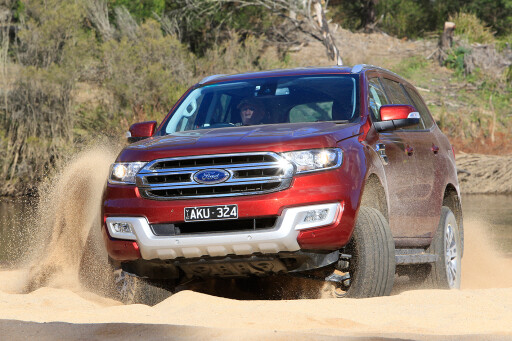 As a back up, the driver also has a rear diff lock to call upon and, unlike most competitor vehicles, engaging the rear locker doesn’t cancel the traction control across the front axle, which is a notable positive.
As a back up, the driver also has a rear diff lock to call upon and, unlike most competitor vehicles, engaging the rear locker doesn’t cancel the traction control across the front axle, which is a notable positive.
All combined, the Everest is an impressive off-road performer right off the showroom floor, even on its standard H/T tyres – provided it doesn’t get muddy. On a negative note, the air intake is under the bonnet lip; although, Ford offers an accessory snorkel to alleviate this shortcoming.
Cabin, Accommodation and Safety
There is no smart key or push-button start for the Everest, even at Titanium spec. Nor is there any reach adjustment for the steering wheel. Get over all that and you’ll find the Everest is still very well-equipped and is a very comfortable place to be for the driver and front passenger.
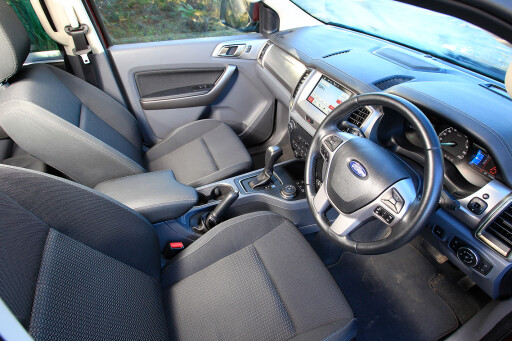 There’s plenty of room in the second row, and while the third row isn’t as roomy as some, at least the Everest has one, unlike the Trailhawk or indeed any Grand Cherokee.
There’s plenty of room in the second row, and while the third row isn’t as roomy as some, at least the Everest has one, unlike the Trailhawk or indeed any Grand Cherokee.
With the third-row deployed, the Everest offers a surprising amount of luggage space. It has plenty of useful features, such as power outlets – even a 230-volt – and drink holders in the cabin. The Everest also has a five-star ANCAP safety rating.
Practicalities
The Everest Trend runs on 18s wearing 265/60Rs, but the 17s, with their taller 265/65s from the base model can be readily fitted. There’s also an under-mount full-size spare.
These tyre sizes are the same as the Prado, which is handy, while there’s also a decent range of Ford and aftermarket accessories for the Everest to make it more off-road ready.
 For those wishing to tow, the Everest is rated for 3000kg. That’s less than the Trailhawk, but still more than many competitors including the Prado.
For those wishing to tow, the Everest is rated for 3000kg. That’s less than the Trailhawk, but still more than many competitors including the Prado.
2017 FORD EVEREST TREND SPECS
Engine: In-line 5cyl turbo-diesel
Power: 143kW @ 3000rpm
Torque: 470Nm @ 1750-2500rpm
Gearbox: six-speed automatic
Kerb Weight: 2407kg
GVM: 3100kg
Towing Capacity: 3000kg
Fuel tank capacity: 80 litres
ADR fuel claim: 8.5 litres/100km
On-test consumption: 11.0 litres/100km
Prices:
Ambiente: $52,990
Trend: $58,990
Titanium: $74,990
*4x4 models only. Prices do not include on-road costs.
2017 Jeep Grand Cherokee Trailhawk
The Trailhawk is the new star in a revamped 2017 Grand Cherokee range, and it’s pitched at buyers who wish to maximise the off-road capability of their Grand Cherokee without going beyond a showroom-stock model. In a way, it’s a showroom ‘custom’ based on the top-spec Overland; although, it ends up cheaper than the Overland.
 The Trailhawk’s key off-road hardware includes an electronic rear locker, height-adjustable air suspension in a unique Trailhawk ‘tune’, extra underbody protection, a bespoke front fascia for a better approach angle, front recovery hooks (otherwise an option), all-terrain rubber on special-pattern 18s and, like it or not, blacked-out bonnet panels.
The Trailhawk’s key off-road hardware includes an electronic rear locker, height-adjustable air suspension in a unique Trailhawk ‘tune’, extra underbody protection, a bespoke front fascia for a better approach angle, front recovery hooks (otherwise an option), all-terrain rubber on special-pattern 18s and, like it or not, blacked-out bonnet panels.
Powertrain and performance
The Trailhawk comes with the Grand Cherokee’s familiar 3.0-litre turbo-diesel V6 engine from Italian diesel specialist VM Motori. It claims 184kW and 570Nm, well up on the Everest’s 143kW and 470Nm.
This more powerful V6 then has the advantage of a slick eight-speed ZF automatic, whereas the Everest has to make do with six speeds in its auto. The Trailhawk is also lighter than the Everest by some 100kg, and possibly more aerodynamic, especially at the lower highway ride-height afforded by the height-adjustable air suspension.
 It’s no surprise then that the Trailhawk produces a level of response and pedal-to-the-metal performance that the Everest simply can’t match. What’s more, the refinement of this V6, especially in terms of noise, is well ahead of the comparatively gruff Everest engine.
It’s no surprise then that the Trailhawk produces a level of response and pedal-to-the-metal performance that the Everest simply can’t match. What’s more, the refinement of this V6, especially in terms of noise, is well ahead of the comparatively gruff Everest engine.
Still, the Trailhawk’s V6 isn’t perfect, particularly in the default ‘Eco’ mode which has the throttle response, especially off idle and at low revs, feeling a little doughy. Cancelling the Eco mode via a dashboard button, or by activating the Sport mode (adjacent button), brings sharper throttle response.
 The Trailhawk’s lighter weight and aero advantage could also be behind its better fuel economy. With a handy fuel capacity of more than 90 litres, the Trailhawk’s range is some 150km more than the Everest’s.
The Trailhawk’s lighter weight and aero advantage could also be behind its better fuel economy. With a handy fuel capacity of more than 90 litres, the Trailhawk’s range is some 150km more than the Everest’s.
On-road ride and handling
The superior performance of the Trailhawk’s powertrain is reflected in sportier and tidier on-road dynamics. Thanks to its lower stance than the Everest – even in normal ride-height mode, let alone the highway-speed Aero mode – less weight and fully independent suspension, the Jeep is clearly a vehicle that a keen driver will enjoy more than the Everest.
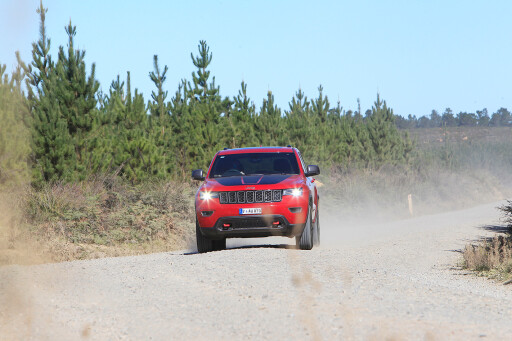 The Trailhawk has the road feel of a passenger car – and a good one at that – while the higher-riding Everest feels more like a 4x4. On bumpy roads, especially at higher speeds, the Trailhawk’s independent rear suspension is noticeably better and provides a stability the Everest can’t match.
The Trailhawk has the road feel of a passenger car – and a good one at that – while the higher-riding Everest feels more like a 4x4. On bumpy roads, especially at higher speeds, the Trailhawk’s independent rear suspension is noticeably better and provides a stability the Everest can’t match.
Like the Everest, the Trailhawk has electric steering (new for 2017 across the Grand Cherokee range) that’s light at parking speeds but firms up at highway speeds. The height-adjustable air suspension provides a generally supple ride, no doubt helped by the decent amount of sidewall afforded by the 18s.
Off Road
The height-adjustable suspension plays a key part in the Trailhawk’s off-road performance. The fact you can jack it up to provide 260mm of clearance puts it significantly higher than the Everest – or, in fact, any competitor vehicle with fixed ride height. On our test, the Trailhawk comfortably cleared obstacles that caught the underside of the Everest.
However, there’s a problem here with the Trailhawk. Despite being height adjustable, the Trailhawk’s suspension doesn’t have as much travel as the Everest and, jacked right up, the Trailhawk’s ride becomes harsh and sometimes noisy as the suspension tops out due to the limited droop travel it has when extended.
 On gnarly tracks, the Trailhawk also readily lifts wheels in situations where the Everest, with its much longer suspension travel, is far more composed.
On gnarly tracks, the Trailhawk also readily lifts wheels in situations where the Everest, with its much longer suspension travel, is far more composed.
The Trailhawk can be jacked up in two stages for off-road use, initially from the default 205mm road clearance to 233mm (fractionally higher than the Everest) and then up to 260mm at max lift. At the first off-road setting, the ride, though not plush, is still good and is all you need for most trail and beach driving.
 Compensating for the Trailhawk’s lack of suspension travel, at least in terms of capability not comfort, is a smart and effective 4x4 system.
Compensating for the Trailhawk’s lack of suspension travel, at least in terms of capability not comfort, is a smart and effective 4x4 system.
Unlike the Everest, the Trailhawk has an automatic self-locking rear diff to match its automatic self-locking centre diff, and it has its own terrain-control system called Selec-Terrain, which has Sand, Snow, Mud and Rock settings.
 The Trailhawk’s extra underbody protection means that there are steel plates to guard the engine, transfer case and fuel tank, but the rear bumper looks vulnerable and needs rock rails or a tow bar to stop it catching on snags.
The Trailhawk’s extra underbody protection means that there are steel plates to guard the engine, transfer case and fuel tank, but the rear bumper looks vulnerable and needs rock rails or a tow bar to stop it catching on snags.
There are also no recovery hooks at the rear, which seems at odds with the set-up at the front. The location of the engine air-intake under the bonnet lip – as per the Everest – is also something to be aware of before getting too adventurous with water crossings, even if the air-filter box is big, tall and drained.
Cabin, Accommodation and Safety
As ever, the Grand Cherokee’s cabin is nicely detailed, comfortable and roomy, and benefits in terms of rear-seat and luggage space from not attempting to squeeze in third-row seating like the Everest. Not so good is the tight driver’s footwell that’s further crowded by the foot-operated parking brake. You also feel like you’re sitting low in the Trailhawk, more like a conventional wagon than a tall 4x4.
 Given the Trailhawk sits near the top of the Grand Cherokee model range, its no surprise it comes loaded with kit, especially when you consider even the base-model Laredo features keyless entry and start, electric seat adjustment, dual-zone climate, a reversing camera, and seven airbags to help it achieve an ANCAP five-star safety rating.
Given the Trailhawk sits near the top of the Grand Cherokee model range, its no surprise it comes loaded with kit, especially when you consider even the base-model Laredo features keyless entry and start, electric seat adjustment, dual-zone climate, a reversing camera, and seven airbags to help it achieve an ANCAP five-star safety rating.
Practicalities
The Trailhawk comes with all-terrain rubber, specifically 265/60R18 Goodyear Wranglers. This size is widely used (by Prado and Hilux, among others), which is a bonus, but the large front brakes mean that 17s can’t be fitted to open up the tyre choice even further, as they can be with the Everest.
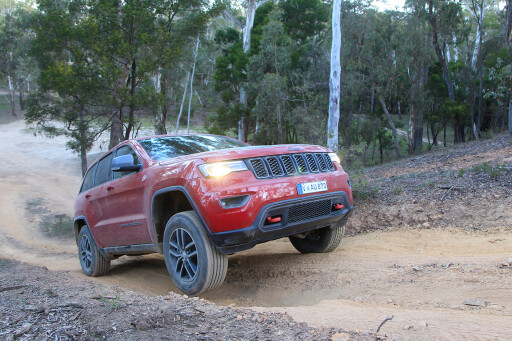 There’s also a problem with the spare, as it’s not a match for the road wheel/tyre combination. Carried in a well below a flip-up cargo floor, it’s a narrower 245/65R18 road tyre on a steel rim – at least it’s not speed or distance restricted as per most space savers.
There’s also a problem with the spare, as it’s not a match for the road wheel/tyre combination. Carried in a well below a flip-up cargo floor, it’s a narrower 245/65R18 road tyre on a steel rim – at least it’s not speed or distance restricted as per most space savers.
The Trailhawk’s substantial 3500kg tow rating – 500kg more than the Everest – is a notable bonus.
2017 JEEP GRAND CHEROKEE TRAILHAWK SPECS
Engine: V6 turbo-diesel
Power: 184kW @ 4000rpm
Torque: 570Nm @ 2000rpm
Kerb Weight: 2300kg (approx)
GVM: 2949kg
Towing Capacity: 3500kg
Fuel tank capacity: 93.5 litres
Prices:
Laredo 3.6L V6 petrol: $52,500
Limited 3.6L V6 petrol: $62,500
Laredo 3.0L V6 TD: $59,000
Limited 3.0L V6 TD: $69,000
Trailhawk 3.0L V6 TD: $74,000
Overland 3.0L V6 TD: $80,000
SRT 6.4L V8 petrol: $91,000
*4x4 models only. Prices do not include on-road costs
The verdict
Putting aside price and looking purely at the core attributes of both the Trailhawk and Everest, it’s clear the Jeep does its best work on-road. Compared to the Everest, it offers considerably stronger performance, noticeably sharper and sportier handling, superior powertrain refinement, lower fuel use, and a longer touring range. As a back-road tourer, it’s very hard to go past.
For its part, the Everest does its best work off-road thanks largely to its extra wheel travel. It mightn’t be more capable than the Trailhawk off-road, but it’s certainly more comfortable and nicer to drive for extended periods on dirt, which makes it the first choice for off-road driving. The Everest also seats seven, so that could be a deal breaker if it’s extra seats you need.
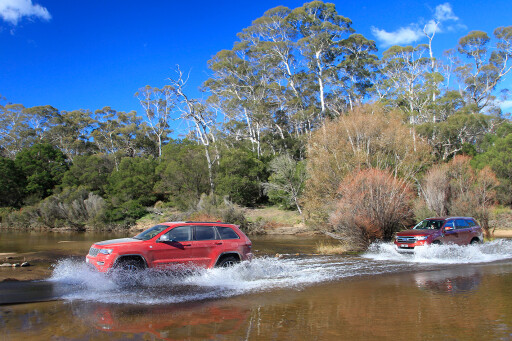 The Trailhawk ($74,000) slightly undercuts the Everest Titanium ($74,990) and has features including keyless entry and push-button start, which the Titanium lacks. However, the Jeep misses out on the Ford’s high-end safety kit, at least as standard, which requires dipping into the extra-cost options.
The Trailhawk ($74,000) slightly undercuts the Everest Titanium ($74,990) and has features including keyless entry and push-button start, which the Titanium lacks. However, the Jeep misses out on the Ford’s high-end safety kit, at least as standard, which requires dipping into the extra-cost options.
Most of the extra kit on the Titanium over the mid-spec Trend is also worthwhile, except the 20s would need to be downsized to the 17s or 18s for 4x4 use.
If you want what the Trailhawk effectively offers but at a lower price, a $59,000 Laredo with the $4000 off-road option pack – so $63,000 in total – would do a similar job, as you get the rear locker, height-adjustable suspension, extra underbody protection, and AT 18s.
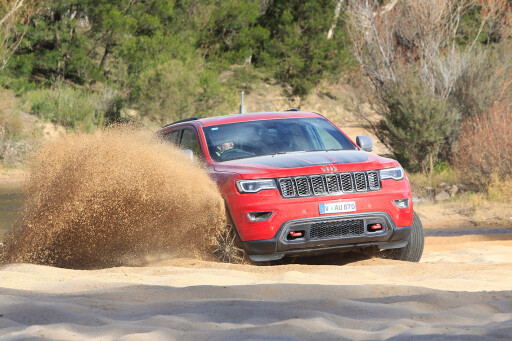 Jeep claims the Trailhawk’s suspension has a unique tune, but what difference this makes over the air-suspension on the Overland – or optional on the Laredo or Limited – is hard to say without a back-to-back comparison. According to the specs, it doesn’t offer more clearance.
Jeep claims the Trailhawk’s suspension has a unique tune, but what difference this makes over the air-suspension on the Overland – or optional on the Laredo or Limited – is hard to say without a back-to-back comparison. According to the specs, it doesn’t offer more clearance.
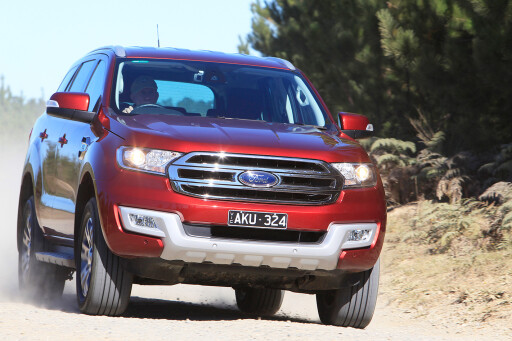 If it’s a budget-buy you’re after, Ford’s $53,000 Ambiente option looks even better. A bit skinny on kit, but it’s mechanically identical to the Titanium, and it comes pre-fitted with 17s, so there’s no need for a wheel swap. However, at this entry point, the Everest is not as well-equipped as the base-model Grand Cherokee Laredo.
If it’s a budget-buy you’re after, Ford’s $53,000 Ambiente option looks even better. A bit skinny on kit, but it’s mechanically identical to the Titanium, and it comes pre-fitted with 17s, so there’s no need for a wheel swap. However, at this entry point, the Everest is not as well-equipped as the base-model Grand Cherokee Laredo.

COMMENTS